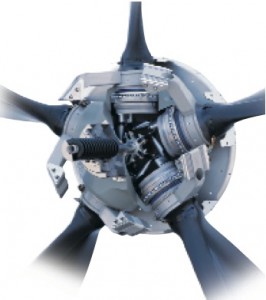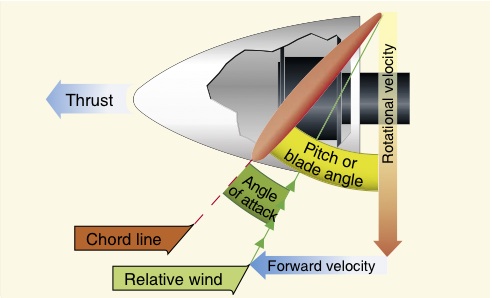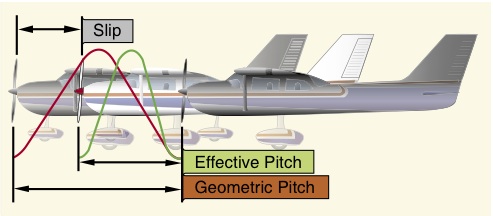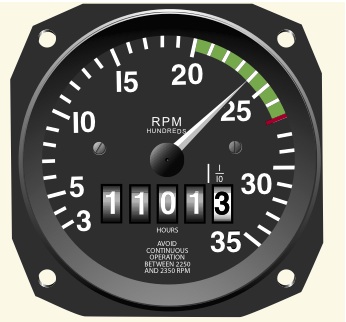 A listener to The Stuck MicAvast recently asked how a constant speed propeller works. Before we answer this question we must understand why airplanes have constant speed propellers and the basics of how a propeller works.
A listener to The Stuck MicAvast recently asked how a constant speed propeller works. Before we answer this question we must understand why airplanes have constant speed propellers and the basics of how a propeller works.
Why The Constant Speed Prop?
The propeller converts rotational power from the engine into thrust. The rotational power is called torque. To better understand torque, imagine your twisting a lid off a can of peanut butter. The muscles in your hand and arm converted into power to turn the peanut butter cap is called torque.
Some cans of peanut butter are very hard to open so we either need to use more power by exerting ourselves or handing the jar of peanut butter to someone who is stronger. Another way we can get the can open is by using our strength more efficiently by using a tool that converts the power in our hands and arms into greater torque. You may have seen such devices at a kitchen store or on late night TV selling for $9.99. I know what your thinking. When am I going to say "But wait there's more!" Now that we have our jar of peanut butter open let's see how this relates to our propeller.
Similar to the tool helping us open the jar of peanut butter the constant speed prop is a device which allows us to efficiently convert power from the engine into thrust. To understand how the constant speed prop works lets first review how a fixed pitched propeller works.
Propeller Basics
Before powered flight, pilots were flying gliders and some of the most successful were flown by the Wright Brothers. The challenge in keeping these early air machines aloft was in how they could move the plane through the air under its own power thus producing enough air speed over the wings to stay aloft.
Many early attempts at powered flight failed but a common theme amongst the earliest flying machines was a device called a propeller. This device had two small wings attached to a rotating hub on the front of the flying machine rotating vertically, moving air just as a fan moves air. A fan must be attached to a base or it will fall forward since the air being pulled through the fan produces a forward force called thrust.
The Wright Brothers where successful in placing an engine on an aircraft and converting the power to turn the propeller and produce enough thrust to cause the aircraft to take off under its own power. We have come a long way since those early days but the basics of propeller operation are the same.

A propeller blade is designed similar to a wing but it must work while rotating about a center hub. Similar to a wing the propellers "cord" is an imaginary line drawn from the center of the leading edge to the rear of the propeller. The "blade angle" is a measurement of the distance between the propeller cord and the plane of rotation, which is fixed in one position on most airplanes. When we speak about propellers though we don’t talk about the blade angle we talk about the pitch of the propeller.
Propeller “pitch” is the distance in inches which the propeller would screw through the air in one rotation. When changing the blade angle we change the pitch of the propeller and use the term controllable pitch propeller. Therefore when we change the blade angle we are changing the distance the propeller would screw through the air and are controlling the pitch of the propeller. Therefore we call them controllable pitch propellers. Note: if you are seeking your flight instructor rating it is a good idea to understand the different terms pitch and blade angle.
Why Use A Constant Speed Propeller
Most single engine aircraft are equipped with a fixed pitch propeller which is efficient at a specific forward speed. Normally the propeller design of a fixed pitch propeller is a compromise of efficiency between cruise and climb. The reason a propeller is most efficient at a specific speed through the air is due to “propeller slip”.

Propeller slip is the difference between the theoretical pitch, geometric pitch, and the actual pitch, effective pitch, of the propeller. An efficient propeller is one which has the least amount of slippage and therefore converts more engine horsepower into thrust. A constant speed propeller keeps the propeller pitch adjusted for maximum efficiency for most conditions of flight.
Takeoff
During takeoff we need the most power and thrust. Remember we are not moving through the air very fast and a low blade angle does a few things. First, it keeps the Angle of Attack small and efficient with respect to the relative wind. Second the engine turns at a higher RPM and therefore converts the most fuel into heat energy for a given time. Third, the low pitch causes a smaller mass of air to be handled by the propeller but the high RPM and low speed causes maximum thrust.
Climb
As we liftoff and climb, the speed of the airplane increases and automatically changes to a higher angle, again greater pitch. The change in the blade angle increases the air handled in one revolution. The new blade angle will keep the RPM constant during the initial climb.

After the initial climb and at a safe altitude the pilot will select a power setting to initiate the remainder of the climb to altitude. This is done by first reducing the power by decreasing the manifold pressure.

Next we must increase the blade angle and lower the RPM. A good rule of thumb is to make sure the manifold pressure is less than or equal to the propeller RPM but of course you will reference your engine operating manual to reference the proper setting.
As you climb to altitude in a normally aspirated, non turbo charged engine, you will need to constantly increase your manifold pressure as you climb since the air is less dense as you climb. If you climb to higher altitudes the throttle will eventually need to be increased to maximum. After the throttle is at maximum power setting there is not much you can do, except buy a turbo charged engine.
Cruise
Leveling off at cruise altitude let the airplane accelerate to the desired airspeed. Since you will no longer need the excess power to accelerate, reduce the power. Reduce by first reducing the manifold pressure and then increase the blade angle to decrease the rpm.
After everything has stabilized in cruise and before you complete your cruise checklist this would be a good time to verify the proper power setting and lean the engine. During your preflight you estimated a specific true airspeed, TAS, and a power and fuel burn. Most airplanes have a quick reference chart available to verify the cruise setting. If you don’t have one I think it is a good idea to make one and laminate it for quick reference.
Descent
During a descent you must reduce the power and point the nose of the plane downward. This will normally increase the airspeed which the propeller will automatically adjust for and increase the blade angle.
In the next part in the series on how a constant speed propeller works we will be talking about the mechanics of how the propeller works. But for now know that there are mechanical stops that prevent the blade angle to be increased beyond a maximum setting which would occur during high velocity descent. Therefore even with the power set at a minimum you will eventually see an increase in rpm as you increase the airspeed.
As you slow for landing the pitch of the blade will decrease until reaching a mechanical stop. Before you land you will need to place the propeller control in the low pitch and high rpm setting because you might need the power for a go around. If we never did go arounds you could leave the prop control alone until after landing, but we all know this is not a good idea because we all plan to go around on every landing. Right?
With that said as you become more experienced in flying a constant speed prop you will notice that you will be able to set the RPM during cruise and have the quiet sound of a lower rpm setting all the way down to touch down. As you slow the aircraft the angle of the propeller blade decreases until it reaches its stop. To add to passenger comfort and to be a smoother pilot you should get to know what airspeed the propeller will contact the mechanical stop while the throttle is at a low power setting. If you advance the prop lever to max RPM you will not hear any change in RPM which means you are at the mechanical stop. Do this and you and your passengers will appreciate the lack of noise created by the change from a ham fisted pilot.
Now that you know how a constant speed propeller works from an operator’s perspective lets see how the mechanical device of moving the propeller works. We will look at both constant speed propellers and full feathering propellers used on twin engines. Do you know why we would want a full feathering propeller on a twin and not on a single engine aircraft? Stay tuned for Part 2 The Mechanics of The Constant Speed Propeller.
Safe Flying!
Reference:
McCaulley Propeller
Pilot's Handbook of Aeronautical Knowledge FAA

Comments on this entry are closed.
Realy nice way and method of explaining aviation topics
The word ‘YOUR’ denotes ownership! eg Your car, or Your house. The word ‘Your’ cannot be used in place of the abbreviation for ‘YOU ARE’ or YOU’RE as in You are twisting a lid off a bottle of peanut butter or You’re twisting a lid off a bottle of peanut butter.
Woah! I’m really digging the template/theme of this
site. It’s simple, yet effective. A lot of times it’s very difficult
to get that “perfect balance” between user friendliness and visual appearance.
I must say you have done a superb job with this.
In addition, the blog loads very fast for me on Firefox.
Superb Blog!
as the forward velocity of aircraft increases, the angle of atack of propeller blade decrease how ?
thanks in advance
I see you don’t monetize your site, don’t waste your traffic, you can earn additional bucks every month because you’ve got high quality content.
If you want to know how to make extra money, search for: Ercannou’s essential tools best
adsense alternative
Security cameras – Many people are currently quite informed
about security camera systems while they often see these
installations in banks, buildings, malls, groceries, and even in houses.
This nifty device will be handy because your traverse back
from the wilderness to Caribbean resort. In this article I
am going to speak about various top features of an extra mobile phone
and I will require the Gresso sol model just as one example.
Hi friends, its wonderful piece of writing regarding cultureand
entirely explained, keep it up all the time.